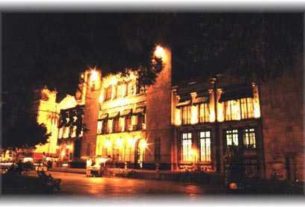At Home in Talpa de Allende, Jalisco
Heaping platters of steaming, grilled, fried and roasted pork are set on the table and stacks of hot tortillas, wrapped in thick towels are placed near you. When you can’t walk and you have to roll away from the table, you know you’ve been to a Mexican pig party!
I’m not talking about those famous luaus on Waikiki Beach in Hawaii where a hole is dug in the sand, logs and rocks are piled in the bottom and set afire. Banana stalks and leaves are laid on the rocks and the hog or pig, depending on the size of the party, is doused with a good barbeque sauce and placed on the leaves. More leaves are used to cover the meat, and then it is topped off with wet burlap bags and a protection cover is rigged with a tarp and more sand. Eight hours later you eat, if you can, after all the hula dancing and Mai Tais.
I’m not talking about Hog Killing Day in the deep South when neighbors got together on a cold, frosty October morning to begin the preparation of the pork we would eat all winter and into the spring.
The men were responsible for killing, scalding, scraping and butchering the hog. They also had the job of rendering the scraped skin and its thin layer of fat underneath into cracklings. We do the same thing in Mexico today, but we call them chicharrones instead of cracklings. In fact, the same method is used with a slight difference. In Mexico a fire is built under a copper or tin pot and these days the heat is usually provided by a gas burner. We used a big, black iron pot in the south and the fire source was wood. I don’t remember sitting around snacking on cracklings like the Mexicans do their chicharrones, sometimes sprinkled with lime juice and cayenne pepper. We used ours for crackling cornbread. Go ahead. Slurp. You’ll find a recipe at the end of this article. I’ve Mexicanized it.
The womenfolk were in charge of making sausage, head cheese or brawn and canning certain cuts, such as the ribs. You’ll never get the highly guarded family recipe for head cheese from me! When it came into my possession and I was entrusted with its safekeeping, I burned it! I hated head cheese. Yes, I know it is served all over the world, called by different names and considered a delicacy. I still hate it.
Can you imagine boiling up all the pig parts that one wouldn’t eat otherwise, throwing a few bones in for the marrow, adding a little spice and vinegar, and calling it a delicacy?
The women had already sewn up clean muslin bags, measuring about twelve to eighteen inches long and two inches in diameter to put the sausage in. General Electric had just come out with its first steam iron and hadn’t even dreamed of food processors yet, so we used a hand grinder to grind the meat for the sausage mixture. There is an art to making good country pork sausage and whether you think it’s good or not depends on where you come from. We always had sage growing in our garden, which we had picked and dried along with the hot peppers, back in the summertime.
I can see those women now with their hands buried in a bowl of sausage meat squishing through their fingers. A hot, black iron skillet stood ready on the stove to cook bits of the sausage mixture in, so they could get the seasonings just right. They would fry up a little and pass it out to where the men were working.
“What do you think about this?”
“It could use a tad more sage,” one might say.
There was no set recipe for making sausage, or anything else for that matter. You used a pinch of this, a dab of that and a right smart of the other.
I well remember my mama telling a new daughter-in-law how to make a good biscuit for her son.
“For about two cups of flour, you put in about a three-finger pinch of baking powder, a little bit of salt, some shortening and buttermilk.”
My sister-in-law asked her, “But Mama, how much shortening would I use?”
“Oh, about the size of your average hen egg,” was her answer.
“And how much buttermilk would I use?”
“Just enough so that it feels right.”
I’m surprised I ever learned to boil water.
Hog killing meant a day of hard work. We had our own smokehouse where the large cuts of meat were salted down in special wooden boxes or hung for smoke curing.
At the end of the work day, there was always a pork roast, mashed potatoes, plenty of gravy, and green peas or green beans plus hot biscuits.
Almost everything about the pig, except the hair, is used when preparing a Mexican pig party.
In the part of the Sierra Madres where I live, there will be mariachi, Norteña or ranchera music playing. There’s the tantalizing smell of roasting pork in the air. The ever-present bottle of tequila will be on the table, and all the men will have on their hats. No genuine Mexican ranchero would ever consider take his sombrero off at a country pig party.
This eating pig-out binge usually begins with homemade cheeses, guacamole, toasted tortillas and a plate of cucumbers, jicama and whatever fruit is plentiful at the time, sprinkled with salt, lime juice and cayenne pepper. This is the dish we call Pico de Gallo or Rooster’s Beak. Depending on the time of the year, you’ll probably be served corn on the cob and over-cooked zucchini. The next dish makes its appearance and you’ll never get its recipe from me either. Moronga! Blood sausage is a dish that is served from ancient Polynesia to modern Asia. Keep it off my table, please.
Besides frying the pork skins, as earlier described, you may find them pickled. All the fat has been scraped from the skin before they are dunked into boiling water long enough to tenderize them. They are drained well, sprinkled with vinegar and salt. These are called brevas here in Talpa. There will be a variety of red and green sauces made from different chile peppers. Try out one of the sauces on a breva. You might like it. The main pig fest is yet to come.
Heaping platters of steaming, grilled, fried and roasted pork are set on the table and stacks of hot tortillas, wrapped in thick towels are placed near you. You are served a plate with a generous serving of tasty beans called frijoles de la olla, cooked in a clay pot. Today’s modern Mexican rancher will provide a knife, fork and napkin, but traditionally, you are expected to take a tortilla in hand and reach for a piece of meat with it instead of using a fork. The experienced pig-out diner will have no need of knife, fork or napkin. The tortilla is his eating tool and his chin wiper.
Dessert is rarely served at a Mexican pig party unless it is a birthday.
When you can’t walk and you have to roll away from the table, you know you’ve been to a Mexican pig party!
Mexicanized Mexissippi Style
Crackling Cornbread
- 1 c. corn meal (I have mine ground at a tortillería)
- 1 c. flour
- 2 tsp. baking powder
- ½ tsp salt
- 4 eggs, slightly beaten
- 1 c. buttermilk (I use regular milk and add 2 Tbs vinegar)
- 2 c. cream style corn
- 1 c. grated cheddar cheese
- ¼ to ½ c. canned jalapeño pepper, chopped
- 1 c. chicharrones, broken into pieces the size of your thumb nail
- 1/2 stick of butter, melted
- 2 Tbs. melted butter
Preheat oven to 425 F. Combine cornmeal, flour, salt, baking powder, corn and cheese in a large mixing bowl and blend well. Add one half stick of melted butter, buttermilk, chilies and eggs. Mix thoroughly. Add and mix in chicharrones. Melt 1 Tbs. butter in each of two 9-inch iron skillets. Divide the batter between the two skillets and bake for 45 minutes.
Serve hot with a big bowl of black-eyed peas and have a happy 2008!



When are the chicharones added? into the batter? Sprinkled over the top?
They are added into the batter before baking.